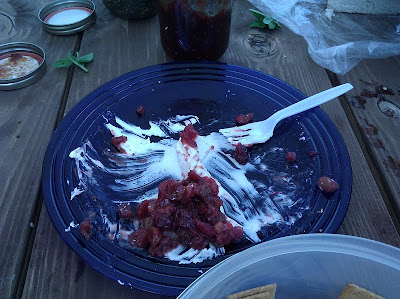 |
| Jennie Schacht, Farmer's Market Desserts |
I clicked on her page and studied the friendly face and hands that lightly clutched a bounty of farmer's market fruit. I gazed at pictures of delicacies from her kitchen and was instantly reminded of my great aunt Yetta -- who I don't think I ever met but know as the legendary sister of my grandmother, the one who was so gifted in the kitchen that she could bake a cake in a hat box. My grandmother, not so much.
I never knew if Yetta's hat-box miracle was a sort of Depression-era compliment or a statement of fact, but it got me wondering. Here is another baker .. one with her name on three published cookbooks ... and the same last name as my grandparents. Was it possible that she and I were related?
Stranger connections have been made through social media, so I took a chance. At 11:33pm on August 14, I sent this message:
My grandparents were Lou and Ella Schact, who owned businesses in NYC when they were young and later retired to NJ, where I grew up. There also was family in Connecticut, I think. It's an uncommon name anymore -- I don't suppose we have a connection?
I shut down the computer and started to wonder if I'd made a mistake. Perhaps the Jennie on the other end would send the equivalent of a sorry-wrong-number reply, or just ignore me.
But she didn't. Her enthusiastic response, fired back just minutes later but not seen until the next day, was so fabulous that thinking of it still gives me goosebumps. Her grandmother was indeed the famous Yetta, sister to my grandmother Ella. And to make the connection more complete, her grandfather Ben was the brother of my grandfather Lou. Two brothers married two sisters, all long gone -- and now two cousins, happily connecting over decades and miles and a long-buried family dispute that took weeks of sleuthing to finally figure out.
Jennie, named for our grandmothers' mother, promptly sent a treasure trove of old photos and a family tree created by younger cousins for a bar mitzvah project. I can hardly describe the thrill of seeing my name on the tree, full of leafy branches I knew virtually nothing about. I quickly updated our twig and sent it back, thus staking a claim on seeds that took root and flourished mostly on the west coast.
This has been a joyous discovery, one that has connected me with other Schachts and their kin in the months since. I have especially enjoyed the fact of Jennie's celebrated cooking skills, which blossomed as a second career -- an accomplishment I likewise hope to enjoy. Knowing that it contained a chilled plum soup that remains a favorite of her 96-year-old dad, I quickly added her Farmer's Market Desserts (Chronicle Books) to my collection. If you enjoy seasonal cooking, you should do the same.
I've baked several entries from this beautifully illustrated and affectionately annotated book, which features a positively swoony endorsement from David Leibovitz and has earned raves from reviewers in various publications since its release in April 2010. I'm especially keen on her Cornmeal Cake with Fresh Corn & Berries, which seemed the perfect choice when my brother David and his girlfriend Michelle visited for Labor Day weekend.
I decided to use it as my guide once again for Tim's Dec. 24 birthday. We're not traditional birthday cake eaters here, so there's always an opportunity to hunt for something scrumptious to make. We settled on Apple & Honey Bundt Cake, a recipe Jennie suggests as a Rosh Hashanah dessert. Sticking with the seasonal theme, we tweaked it by substituting Harry & David Royal Riviera pears -- an annual and much appreciated Hanukkah gift from Tim's brother -- and even used pear cider for the glaze, creating the ideal birthday-Hanukkah-almost-New-Year's celebration cake.
Jennie shared the above recipe on her blog, Jennie in the Kitchen. Since she welcomes (and even sugggests) creative substitutions, I made a unplanned change by using yogurt when I realized I'd forgotten to buy buttermilk. The resulting cake was rich and moist, with shiny chunks of pear dotting every slice.
It's a delicious if untraditional birthday treat and, factoring in the bonus of being related to the chef, an unexpected sweet. Both are things to be savored.
































